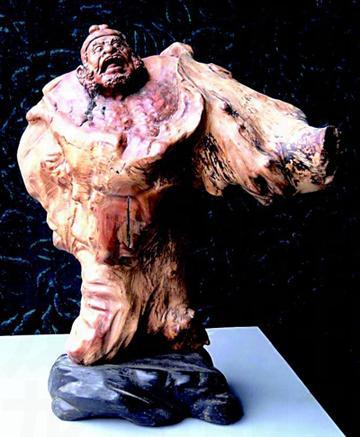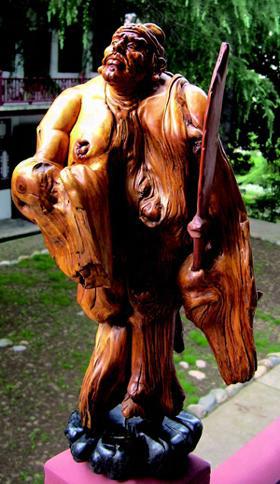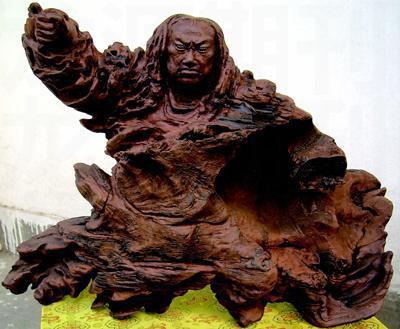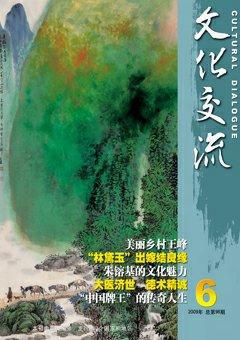108 Outlaws in Root Carvings
Xu Huadang

Master Zheng Jianfu is a leading root sculptor in Zhejiang. In his career nearly 40 years long, he has developed a highly distinct root carving style and helped promote the development of root carving in the country.
A remarkable part of his brilliance as a root carving artist lies in his capability to see the beauty and charm and aesthetic possibilities hidden in roots in their original shapes and conditions. His capability of bringing out the hidden charms out of original roots is more than brilliant.
What makes him standing out as a root carving master is partly attributed to his use of roots beyond the traditional variety. In the early 1990s, he cast eyes beyond traditional raw materials. The unconventional tree roots have greatly broadened his vision and enhanced his creativity. Starting in 1992, he began to create group sculptures. The creations in these years include “18 Arhats”, “12 Beauties of Jinlin” and “Ancient Masters”, which won him top national awards and caught the attention of collectors.
In 1998, he hit upon the idea of carving the 108 outlaws of “Outlaws of the Marshes”, a classical Chinese novel. And he wanted to create these popular images on uniquely shaped roots. Two challenges arose out of the ambition. First, the heroes must satisfy and inspire peoples imagination. The heroes he created would be a total failure if they could not inspire popular approval. Secondly, he needed to find 108 uniquely shaped roots that would fit the images and personalities of these outlaws.
Though quite familiar with the stories of the outlaws from the stories he had heard in his childhood years, Zheng bought discs of television adaptation of the novel and watched it several times. He also read the original novel thoroughly. Some of the 108 heroes are more popular than others, but minor heroes also required his full attention. Zheng believed that a poorly created image of a minor outlaw could ruin the overall beauty of the 108.
He applied two methods in his selection of the raw roots for the 108 outlaws. Personalities and specific personal traits could serve as guidance. For example, Black Tornado Li Kui suggests a man of dark countenance and a personality of audacity, loyalty, hot temper and candor. So he searched for roots that would suggest similar traits and tints. Sorting through dozens of candidate roots after a long while, he chose a blackish root buried in the water for 1,000 years.

The second method was to go through roots and try to see if they match images in his mind. The wide-range selection was a grueling labor. He went through mountains and seas of roots to find ideal roots. Looking back, he concludes that he used 50 plus species of roots that came from Zhejiang, Fujian, Hainan, Yunnan, Taiwan, Gansu, Guangxi and foreign countries such as India, Vietnam and Myanmar.
The project made slow progress while he carved and tried to find ideal roots. He had planned to complete the 108 carvings in three years so that he could present them for the advent of the new century in 2001. It took him three more years and he completed them in 2004.

The time-consuming progress was attributed to the difficulty of finding ideal roots and of recapturing the best moments of these outlaws. Each carving was designed to retell what an outlaw is doing and looking like at a specific moment as depicted in the novel. Each carving must represent the perfect combination of all the right choices: the right moment, the right facial expression, the right movement, the right story, the right root and the right presentation. A tiny mismatch or tiny misrepresentation would abort the whole endeavor.
To depict Wu Song the Walker, Zheng Jianfu considered equally thrilling tales of the hero and finally chose the moment of Wu Songs bloodbath revenge when he broke off the pillory before he knifed every one involved in an insidious setup that would have sent him to the execution ground. After choosing the right root and watching the television episodes in which Wu Song appeared, Zheng had an inspiration one night. He got up and rushed to the studio. He worked two hours on the image. The next morning he came back to the carving and polished it. In a few days, the masterpiece was done.
In bringing out the images out of the roots, Zheng Jianfu focused on the faces of the outlaws so that the inner worlds of these men and women could be seen in their faces. The natural texture in other parts of the images was kept intact. He used as little touches as possible and converted original scars, warts, humps and lumps and other distortions on tree roots to costumes, caps, hair, weapons, etc.
Zhengs sculptures of 108 outlaws are vivid descriptions of the characters of the classical novel. Each sculpture stands 45 cm in height and each retells a vivid story. It is the first ever sculptures of the 108 outlaws in Chinese history. The group sculpture is said to lift the unique Chinese art to an unprecedented plateau. Yang Boda, the former vice president of National Palace Museum in Beijing, commented that the group sculpture was more than a masterpiece and it was a masterwork of the supreme quality and supreme grade. □

